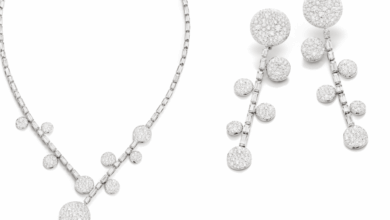
Register to get 1 free article
Reveal the article below by registering for our email newsletter.
Want unlimited access? View Plans
Already have an account? Sign in
Despite widespread digital investment, jewellery retailers still find online conversion rates stubborn —particularly for high-value items. The prevailing explanations tend to focus on pricing sensitivity, technical friction, or suboptimal marketing.
But the most significant barrier is rarely discussed directly: a lack of trust infrastructure.
In a traditional retail setting, trust is ambient. It’s conveyed through environment, conversation, and the perceived credibility of the seller. The customer handles the product physically, inspects it directly and guides their own examination, ask questions, and leaves reassured—not just by what they’ve bought, but by who they bought it from.
Online, those cues are almost entirely absent, outside of product reviews.
And while digital retailers have spent heavily on branding, photography, and customer service, few have addressed the a core risk: the customer’s uncertainty about what happens after the sale.
Buyers are not just hesitating emotionally, they are engaging in a risk assessment. When a customer is considering a £2,000 purchase—particularly one as personal and non-essential as jewellery—they are acutely aware of what could go wrong: loss, theft, damage, delivery disputes, or remorse. And without the natural back-and-forth of an in-person interaction, those concerns are ignored.
In this context, embedded protection serves a very specific function.
Not as an upsell, nor as a revenue driver, but as a trust signal.
When protection is offered seamlessly at the point of sale, it communicates that the retailer has anticipated the customer’s exposure—and built systems to mitigate it.
This mirrors a broader trend across sectors: Amazon’s “A-to-Z Guarantee,” Apple’s extended care, Klarna’s pay-later protections. These aren’t just features; they’re psychological infrastructure. They enable digital transactions by reducing perceived risk. The jewellery sector, however, has been comparatively slow to adapt.
That said, embedded protection will never be a universal rule – it will not transform commoditised categories or compensate for poor site experience and optimisation. It is not a substitute for strong merchandising, nor is it a panacea for weak product-market fit. But for high-value goods where post-purchase confidence is elevated —fine jewellery being a prime example—it is increasingly part of what digital consumers expect.
Retailers who understand this are already integrating protection as part of the core purchase experience. The most effective implementations are quiet, unobtrusive, and positioned as care, and, when done correctly they help to remove doubt and sales friction associated with item longevity and ownership.
Ultimately, customers aren’t hesitant to spend online—they do so regularly, and in increasing numbers. But the difference between a completed sale and an abandoned one often comes down to something that’s not visible in the data: perceived risk.
Embedded cover doesn’t solve every challenge. But it does address a specific one that many retailers overlook: how to deliver trust digitally, at the exact moment a high-value decision is being made.
To see how embedded cover can integrate seamlessly into your online jewellery store—without disrupting your workflow or customer experience—visit: assetsure.com/embedded-insurance-b2b
Ecom Jewellers: The Peace-of-Mind Plugin
Micro-hesitations, or their absence, can be the difference between revenue and regret in high-ticket retail.
Common sense consumer psychology has long shown that the greater the value of a purchase, the greater the emotional friction at the final step. Uncertainty rises, risks appear large and looming. “What if I lose it? What if it’s damaged? What if something goes wrong?” Left unaddressed, these questions stall momentum and result in abandoned sales — both in-store and online.
But, why do shoppers freeze at the finish line?
Behavioural science tells us that shoppers make decisions emotionally, then justify them rationally. But jewellery isn’t just emotional — it’s expensive. And at higher price points, emotion is accompanied by risk sensitivity. Researchers call this anticipated regret: the fear of making a decision that turns out badly.
When a customer imagines losing a £2,000 ring a week after purchase, their brain flags danger, even when they’re deeply happy with their item.
What they want, often subconsciously, is a psychological safety net.
A tickbox that says: “If something goes wrong, you’re protected.”
Embedded insurance provides exactly that, at the precise moment their anxiety peaks.
So, in ecommerce, what tech options do you have to reverses doubt?
Counter to those annoying pop-ups and requests for email addresses the second you land on a site, embedding cover next to the products you sell doesn’t interrupt the sale — it rescues it.
According to multiple retail studies, customers offered protection at point of sale are more likely to complete the purchase, feel reassured, and rate the seller more highly.
For the customer, it’s low effort and low cost.
For the jeweller, it’s twofold: an uplift in conversion by addressing a conversion obstacle, and a new revenue line with no operational overhead. Customers don’t see it as an upsell — they see it as security, which is exactly how it works.
Revenue, reputation and repeat business are more than a “nice-to-have”. When you embed protection into existing buy online journeys the downstream wins for online retailers are:
- You lower buyer anxiety at the most fragile moment
- You add value without asking for more time or trust
- You create repeatable confidence — a key driver of loyalty in premium retail
And it’s entirely passive. Integration is simple, and support and claims are handled by the insurance partner. There’s no added weight on your staff — just a lift in your numbers and an increase in customer goodwill.
Owning fine jewellery is personal, emotional, and valuable. Embedded cover completes that experience—protecting what matters, building trust, and helping close the sale naturally.
It’s a tiny tick box, but it makes a big difference.
To see how embedded cover can integrate seamlessly into your online jewellery store—without disrupting your workflow or customer experience—visit: assetsure.com/embedded-insurance-b2b







